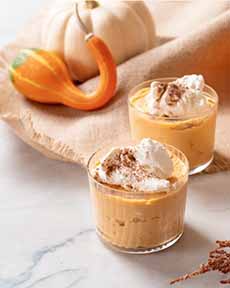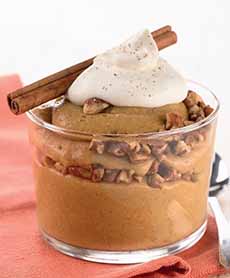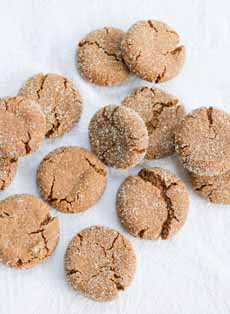Easy Pumpkin Mousse Recipe & The History Of Mousse
|
Whether you need an easy pumpkin dessert for Thanksgiving—no baking, gluten free!—or feel like mousse at any time of the year, here’s a recipe from Straus Family Creamery of California. National Mousse Day is November 30th. National Chocolate Mousse Day is April 3rd. > The history of mousse is below. > The history of pumpkins. This three-ingredient Pumpkin Mousse (plus pinches of nutmeg and salt) is light and flavorful. Prep time is 30 minutes, plus chilling time of 3 hours. 1. HEAT the sweetened condensed milk over low heat for 10 minutes, stirring constantly until the color darkens. 2. ADD the pumpkin purée and stir until combined, bringing the mixture to a gentle boil for 2 minutes; then add the salt. 3. PRESS the mixture through a fine mesh sieve to strain out any solids; then cool completely. While the pumpkin mixture is cooling… 4. WHIP the cream to stiff peaks. Set aside 1/4 of the whipped cream. NOTE: Consider setting aside the 1/4 amount before you whip the rest into stiff peaks. You can always re-whip an under-whipped cream, but once it becomes stiff, you cannot go back. 5. GENTLY FOLD the pumpkin mixture into the whipped cream. Once fully combined, portion into individual serving cups and place in the refrigerator for at least three hours prior to serving. 6. TOP each serving with a dollop of the remaining whipped cream and dust with nutmeg. The first known reference to mousse, a French word that translates to “foam,” dates to the 18th century. Unlike the sweet desserts we know today, those first mousses were savory, made with cheese, meat (including chicken livers and foie gras), seafood, and vegetables. |
|
|
|
The first documented recipe for a sweet mousse, chocolate mousse appears to be in 1750, in a pastry chef’s cookbook La Science Du Maître d’Hôtel Confiseur by Joseph Menon, the most prolific cookbook author in 18th-century France [source]. Whipping cream to incorporate air bubbles gives mousse its light and airy texture (and all that was done with a whisk and a strong arm, in the era before electricity and electric beaters). Following publication, chefs nationwide began to create desserts consisting of whipped cream flavored with chocolate, coffee, fruit, and liqueurs called crème en mousse (“cream in a foam”), crème mousseuse (“foamy cream”), or just mousse. Modern mousses are a continuation of this tradition [source]. By the late 19th century, sweet mousses, including today’s standard-bearer, chocolate mousse, began to gain in popularity [source]. According to one source, the United States first became acquainted with chocolate mousse at a food exposition held at Madison Square Garden in New York City in 1892—although arguably, wealthy people with French-trained chefs might have enjoyed savory and sweet mousses before then [source]. Back to the savory side: A dip of fish mousse with “party slices” of pumpernickel or other brown bread and butter was a popular party food in American cuisine in the 1950s [source]. Why did it take this long? In 1977, New York chef Michel Fitoussi is credited with creating white chocolate mousse, in 1977. He was the chef at the Palace, Manhattan’s most expensive luxury restaurant [source 1] [source 2]. [Editor’s note: We were privileged to eat at the Palace several times, and remember Chef Fitoussi’s innovative cuisine. Some of our favorite dishes were sea urchin soup, a rolled slice of smoked salmon filled with crème fraîche and caviar—which we still make today—and fish pâte topped with foie gras (ditto). We also remember his pastry swan, filled with half chocolate mousse and half white chocolate mousse.] CHECK OUT WHAT’S HAPPENING ON OUR HOME PAGE, THENIBBLE.COM.
|
||





